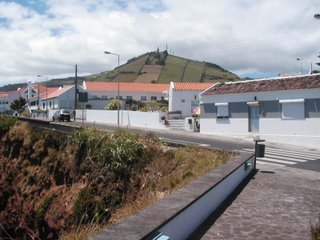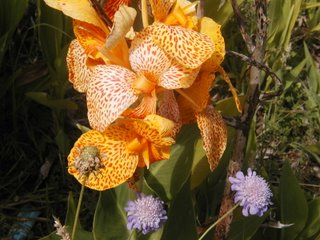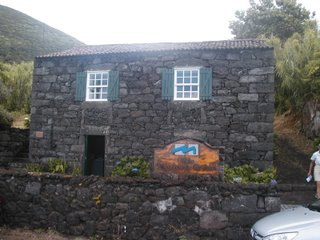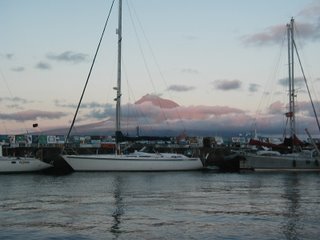The Island of Flores, Azores
Our voyage from Bermuda to Flores in the Azores was one of those trips that make you glad you are out there in a sailboat. We spent eighteen days on the bluest of oceans, visited by dolphins and flying fish and petrels and shearwaters. We listened well to Herb on Southbound II, and travelled much further north than we had ever thought we would to stay in good winds and favourable currents. And good winds and favourable currents we had most of the way, as well as the company of other boats on the radio and friends waiting for us when we made landfall.
Our first sight of Flores was breathtaking. It was dawn, and the sun was beginning to rise. We first saw the island as a great dark rock rising out of the ocean, steep-sided and stark. Then as the sun rose higher it began to soften - we could see the cliffs were topped with trees and hilly slopes covered with a patchwork of green fields. The port of Lajes lay below the cliffs, it’s breakwater a solid line with masts behind it below the buildings that were becoming visible, climbing up the hill into the village proper. We could see rising layers of red tiled roofs, some above old stone walls, the black stones outlined in white, others topping painted cement walls. Above the harbour we could see the church, two cupolas either side of a scalloped triangle of roof with a cross on top. It looked, somehow, exotic.
On shore, we found that every place was up from the harbour. Some of the cruisers nicknamed the trek from harbour to the main street through the town of Lajes the cardiac climb, since only the very fit could make it without feeling their hearts pounding and their breaths coming short. On the other hand, we told ourselves, it was sure to make us fitter. We told ourselves that every time we climbed it... It helped that much of the road, here as in the rest of the island, was bordered by beautiful flowers, big and bright. We saw them in parks and gardens as well - though many of the gardens, front and back, in Lajes were used mainly to cultivate a wide variety of vegetables. That, we were told, was why there was not much of a selection in the stores - almost everyone grew their own. And there were chickens and sheep around the town as well.
In Lajes almost every cruiser and a great many other visitors as well frequent the Cafe Beira Mar, where the owner, Paula, serves as a gateway to Lajes, and to Flores as a whole, as well as being a source for fresh vegetables and fresh-laid eggs. She speaks excellent English, and is ready with information and help of all kinds, including translation services when necessary. To top it all off, the food she serves in her cafe is excellent, something we learned when our first and second evenings were spent watching World Cup football with friends there. It was surprisingly quiet for a group of soccer fans - it would probably have been a lot noisier and certainly much happier if Portugal had won the consolation match.
There may not have been much celebrating then, but the Feast of the Emigrants made up for that. It takes place over a four day weekend, mostly in the evenings, with booths and concerts and on Sunday a free beef lunch (broth with bread soaked in it, and platters with beef prepared two different ways). The lunch is served complete with wine, juice and water at rows of tables set up in the largest building in town, a well-cleaned out municipal garage. Most years there are hundreds of people there but this year the inter-island ferry failed to run, as it has for months, and most of the expected visitors did not come. The festivities went on anyway, and we saw two concerts, one of them including traditional music and dancing, and a magnificent display of fireworks on the cliff above the harbour. There should have been more people there to enjoy it - hopefully the ferry will run again very soon, and the island will benefit from having more visitors.
We visited Flores’ capital, Santa Cruz, by land. The drive there was along winding roads, with views that tempt the visitor to stop frequently. We saw the harbour there, and were glad that the harbour in Lajes has been improved. The coast by Santa Cruz is laced with rocks; the sea foams green around them. The harbour itself is tricky to get into, and tiny. We would not have felt at all comfortable there. Access to Lajes is much easier, but even there one has to mind the weather and watch the direction and strength of the wind. When we left for Horta it was not so much because we wanted to leave Flores as because the coming weather was going to make the anchorage a very uncomfortable place to be. And so we left for Faial, and that place well known to many sailors - Horta.
We planned on the trip, about a hundred and thirty miles, taking about twenty four hours, and left Flores shortly after nine o’clock on a Thursday morning. That way it would certainly be daylight when we arrived off Faial, and if the trip took a little longer than anticipated that would be fine as well. But we were on a broad reach all the way in winds averaging twenty knots, and arrived in Horta only twenty-two hours after we left Flores, earlier than anticipated! We approached the island on a hazy morning, thankful for the GPS co-ordinates that helped us be sure of where we were. There was not much time for sleep along the way, and the journey was too short to settle into a routine, so we spent most of our first day in Horta sleeping...
Horta being one of those destinations favoured by many cruisers, a lot of the people we have met along the way were either here before us or came in shortly after. And it is no wonder many people stop here - a sheltered marina at very reasonable rates, access to shopping and many kinds of services. lots of good company, lots of cafes, bars and restaurants, a constantly changing view of the cone of Pico, across the channel, from your cockpit- all this, and a whole island to explore too. And everything kept immaculately clean - the garbage bins in the marina are emptied three times a day!
The most dramatic scenery to be found in Faial is at the site of the volcano which erupted just off the island in 1957. By the time the eruptions were finished, the volcano had created an island which then became linked to Faial, the nearby lighthouse had been destroyed and many houses in the nearby village were buried under the ash it created. Many of the people displaced moved to North America; John F. Kennedy came specifically to invite them to the United States to resettle there. The landscape left behind is stark, mountains and cliffs of rock and lava rising out of dark, sandy soil. The ruins of a lighthouse still stand there, and not far away you can see the roofs of buried houses. It is an awesome reminder of the power of the earth.
After that the rest of the coast and the fields of Faial feel gentler. Much of the island is green and dotted with houses and hay bales and cattle and horses; there is more flat land here than in Flores. Although the land still slopes precipitously to the sea in many places, and some towns tumble down old volcanic slopes, the ranks of red-tiled roofs arranged along narrow roads. Old and new mix: on one ridge we saw a few old windmills, carefully preserved, and on another close by a row of new windmills for producing electricity. As in Flores, the churches are prominent, very much a part of people’s lives as well as helping preserve both tradition and sacred art. The museum in Horta has a room full of sacred art, as well as a room devoted to carvings using the pith of fig trees, very fine, delicate, detailed depictions of ships and buildings and people. Yet another room showcases current artists.
Horta is getting ready to put on her best face for Sea Week as we write , painting buildings and kiosks, stringing up lights, setting up booths, removing dead trees along the sidewalk and putting in new plants - like a house being prepared for special visitors. We will miss the festivities - we hope to be heading for Terceira and the summer festivals there by the time Sea Week arrives. But in the meantime we enjoy the hustle and bustle and seeing Horta’s waterfront getting all dressed up. And it will be interesting to see how Flores and Faial compare to our next stop...
 Throughout the town festival in Praia da Vitoria the streets along which the parades travelled were decorated with lights and the poles were draped in fabric. Businesses stayed open, and the cafes were always full to overflowing.
Throughout the town festival in Praia da Vitoria the streets along which the parades travelled were decorated with lights and the poles were draped in fabric. Businesses stayed open, and the cafes were always full to overflowing. The town square was all lit up for its part in the Festival. Every night people gathered there to watch the parades (a different one every night), and to enjoy the performances of groups in the parades, followed by another performance on the stage erected at the top of the square, in front of the post office.
The town square was all lit up for its part in the Festival. Every night people gathered there to watch the parades (a different one every night), and to enjoy the performances of groups in the parades, followed by another performance on the stage erected at the top of the square, in front of the post office. When we visited Angra they were getting ready for a Festa there. The main streets were busy, decorated and narrow - and of course from the harbour everything is up.
When we visited Angra they were getting ready for a Festa there. The main streets were busy, decorated and narrow - and of course from the harbour everything is up. The start of a race - round an island to the north of Praia and back, nine miles in all. Starboard or port start, in the end it did not seem to make much difference...
The start of a race - round an island to the north of Praia and back, nine miles in all. Starboard or port start, in the end it did not seem to make much difference...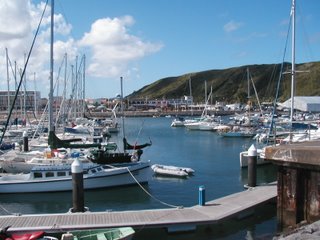 Looking at the marina at Praia da Vitoria, from the breakwater which protects it. There are two Canadian boats in this picture: ourselves,the light blue hull on the right and Joint Venture, the Alberg 37 yawl with the green sail cover, dodger, bimini and weather cloths. There were American, German, French and English boats here as well, and one of the boats racing was Polish. There is also an active fleet of local racers.
Looking at the marina at Praia da Vitoria, from the breakwater which protects it. There are two Canadian boats in this picture: ourselves,the light blue hull on the right and Joint Venture, the Alberg 37 yawl with the green sail cover, dodger, bimini and weather cloths. There were American, German, French and English boats here as well, and one of the boats racing was Polish. There is also an active fleet of local racers.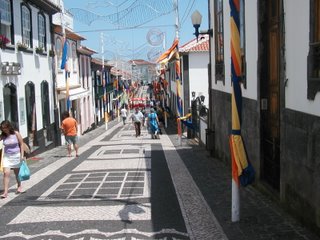 The pavements and sometimes the streets are decorated with patterns created from dark and light stones. This part of this street in Praia da Vitoria from the beach to the square is for pedestrians only.
The pavements and sometimes the streets are decorated with patterns created from dark and light stones. This part of this street in Praia da Vitoria from the beach to the square is for pedestrians only.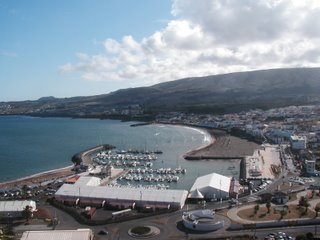 Looking down from a hill above Praia da Vitoria toward the marina and beaches.
Looking down from a hill above Praia da Vitoria toward the marina and beaches. It was a windy day, and this sailor was out for an exciting ride.
It was a windy day, and this sailor was out for an exciting ride.

